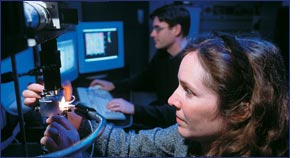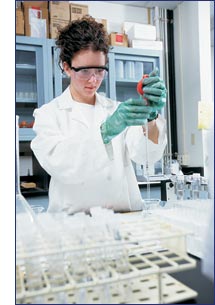|
The Roles of Bacteria, Organic
Compounds, and Climate in Nutrient Cycling and Pollutant Transport
 Patricia A. Maurice, associate professor of civil engineering and geological
sciences, studies microbial trace metal and organic interactions with
mineral surfaces from the atomic scale up to the scale of entire water
sheds, like the Lake Erie Basin or portions of the Atlantic Coastal Plain.
She also examines how extreme climates affect ecosystems. “My research
is very broad,” states Maurice, “but it always uses fundamental
molecular-scale investigations to understand large-scale phenomena like
pollutant transport or the effect of global climate changes on ecosystems.
I apply this fundamental approach to a variety of field situations.” Patricia A. Maurice, associate professor of civil engineering and geological
sciences, studies microbial trace metal and organic interactions with
mineral surfaces from the atomic scale up to the scale of entire water
sheds, like the Lake Erie Basin or portions of the Atlantic Coastal Plain.
She also examines how extreme climates affect ecosystems. “My research
is very broad,” states Maurice, “but it always uses fundamental
molecular-scale investigations to understand large-scale phenomena like
pollutant transport or the effect of global climate changes on ecosystems.
I apply this fundamental approach to a variety of field situations.”
For instance, in collaboration with Diane McKnight, a professor in the
Department of Civil, Environmental, and Architectural Engineering at
the University of Colorado, Maurice has been studying the McMurdo Dry
Valleys of Antarctica, some of the coldest, driest places on Earth. She
suggests that the unique environment of Antarctica actually aids her
research by highlighting processes that can’t be studied in
other locales due to the existence of multiple and concurrent interactions.
The research focuses on the few weeks each year when the glaciers melt
and water flows into the valleys.
What Maurice and her team have found conflicts with their original expectations.
Namely, they found a system of bacteria and algae that blooms quickly
and extremely efficiently in water, demonstrating that at least certain
types of bacteria have the ability to adapt to an ecosystem’s environment.
Their study also showed that minerals in the water experienced chemical
erosion at surprisingly fast rates, perhaps because of the previously
unanticipated microbiological processes.
Another study focuses on the degradation of biological material. Consider
the many different materials present -- such as leaves -- in soil and
other organic matter. As water passes through the soil, it carries with
it some of the molecules from the biological material. When these molecules
pass into the lower soils and eventually aquifers or streams, they begin
to control the biological and chemical reactions and, essentially, determine
the fate of pollutants.
 If, for example, there are a multitude of these natural organic materials
that get into streams, they function as a sun block, preventing ultraviolet
light from penetrating the streams and damaging the organisms in the
water. “Understanding the reactions that control organic matter
on the molecular level,” says Maurice, “will help us predict
how the organic matter will respond to climate change. If we understand
the hydrology and how the water flow affects the amount of organic matter
that enters the streams, as well as the reactions that occur once it
is in the streams, then we can better predict how climate change will
influence the sun-blocking mechanism and perhaps develop ways to lessen
potential ecosystem damage.” If, for example, there are a multitude of these natural organic materials
that get into streams, they function as a sun block, preventing ultraviolet
light from penetrating the streams and damaging the organisms in the
water. “Understanding the reactions that control organic matter
on the molecular level,” says Maurice, “will help us predict
how the organic matter will respond to climate change. If we understand
the hydrology and how the water flow affects the amount of organic matter
that enters the streams, as well as the reactions that occur once it
is in the streams, then we can better predict how climate change will
influence the sun-blocking mechanism and perhaps develop ways to lessen
potential ecosystem damage.”
According to Maurice, the purpose of her research is to engineer solutions.
She believes that with a fundamental knowledge of how a system works,
researchers from a variety of disciplines in the College of Engineering
and throughout the University can design solutions for a wide range of
complex environmental problems. “That’s one of the benefits
of being among a group of engineers,” she says, “instead
of working in isolation with ‘science’ taking place in one
building and ‘engineering’ in another, we are bringing them
together to find answers.” |
 |
 |
 |
 |
 |
|
|

